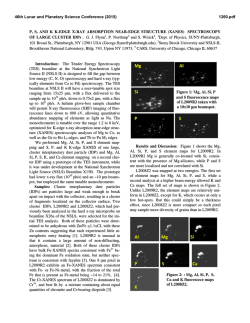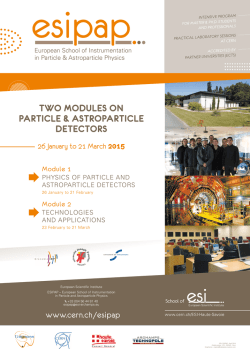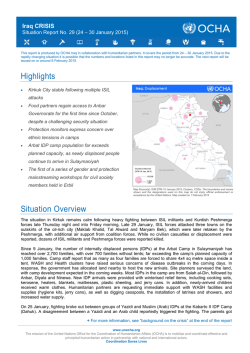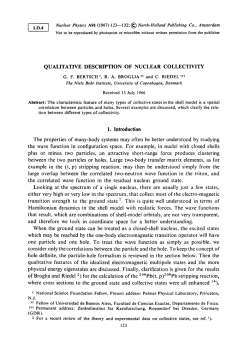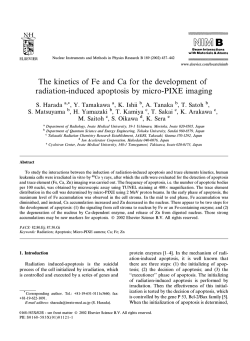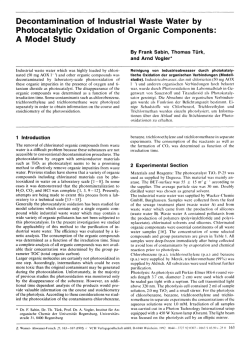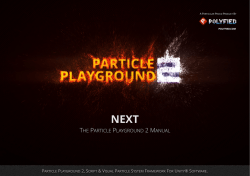
RADIATION HISTORY OF GIANT CLUSTER PARTICLE U2
46th Lunar and Planetary Science Conference (2015) 1705.pdf RADIATION HISTORY OF GIANT CLUSTER PARTICLE U2-20GCA, A PROBABLE COMETARY IDP. R. O. Pepin1, D. E. Brownlee2, R. L. Palma1,3, D. Joswiak2, and D. J. Schlutter1, 1Depart. of Physics, University of Minnesota, Minneapolis, MN 55455, USA: [email protected], 2Depart. of Astronomy, University of Washington, Seattle, WA 98195, 3Depart. of Physics & Astronomy, Minnesota State University, Mankato, MN 56001, USA. Introduction: The IDP U2-20GCA was found on its U2 stratospheric collection plate as a 350 µm dense core of <40µm particles surrounded by a less dense debris field a mm across. The core appears to have been a highly porous large anhydrous chondritic IDP that simply pancaked on impact to form a monolayer of thousands of particles. This IDP is a huge collection of particles that all come from the same parent. In addition to extreme porosity, mineralogical and Ne data discussed below support the likelihood of a cometary origin. Because of its large number of large and varied components, this IDP is an important analog for comet Wild 2 samples returned by the Stardust mission. He and Ne in earlier studies of ~40 fragments from other cluster IDPs (references in [1]) are dominated by implanted solar wind (SW). The unusually large size of the U2-20GCA cluster suggests that many of its constituents could have been shielded from recent irradiation by short-range SW ions in space, permitting a search for other noble gas components. This turned out to be correct: isotopic evidence for SW-Ne appeared in only 3 of the 15 U2-20GCA particles examined in this study, and two components with nonsolar 20Ne/22Ne ratios were found in subsets of the other 12. Almost all of them contain high levels of excess spallogenic 21Ne, indicating intense irradiation by energetic protons at some point in their histories. Experimental: Chemistry and Mineralogy. All 15 of the 6-15µm particles in this work were examined optically and in the SEM, and microtome sections from each were studied in the TEM and saved for future analysis. All 15 particles were compact and survived collection and repeated rolling with a needle in viscous silicone oil. Most of the mass of these particles is in coarse mineral grains but most also contain fine aggregate components. After microtomy, the bulk of each particle was put into Pt foils for noble gas studies. Noble gases. Samples were degassed by stepheating to ~1400°C. Details of the mass spectrometry and experimental protocol used in the He and Ne analyses are given in [1]. Estimates of particle dimensions and mineralogic densities from TEM measurements on the microtomed sections were used to calculate sample masses, assumed uncertain by a factor 2. Discussion: Evidence for cometary origin. In the work on this IDP we were able to find a significant number of ferrous olivine grains whose TEMmeasured minor element compositions provide an important means of comparing a particle’s relationship to chondrites, comet Wild 2 and other IDPs as discussed by Frank et al. [2]. In Fig. 1 it is seen that the MnO and FeO weight % data from U2-20GCA olivine (open circles) are very compatible with Wild 2 olivine (crosses). The total lack of correlation between Mn and Fe and the broad dispersion of the data provide evi- dence for strong similarity with Wild 2 and distinction from many chondrite types including ordinary, CM, CV and CO chondrites. The IDP Cr histogram (Fig. 2) shows general agreement with Wild 2 olivines (Fig. 3) and supports a cometary origin for the IDP and distinc- tion from some primitive chondrite types. Neon and helium. Trapped (non-spallogenic) 20 Ne/22Ne is shown in Fig. 4, arranged approximately in order of increasing ratio. Three distinct isotopic groups are evident: a component (black symbols) with low 20Ne/22Ne scattering between HL-Ne [3] and Q-Ne (or air); another (red) with ratios falling in the Q-Ne field [4]; and a third (yellow) suggesting SW irradiation. HL-Ne is carried in nanodiamonds [3]; evidence for its possible occurrence in an IDP has not previously been seen. However the Q-Ne composition, present in a minor, gas-rich macromolecular organic phase ubiquitous in chondritic and achondritic meteorites [4], has 46th Lunar and Planetary Science Conference (2015) also been identified in the L2071F1 Manchanito cluster IDP [5], in particle fragments in Stardust track 41 [6], and most recently in secondary particles lodged in the surface of Stardust cell C2028 [7]. Q-Ne does not appear to be confined to meteoritic phase-Q. 4 20 He/ Ne ratios in the U2-20GCA samples are low, ranging from <0.1 to 34 and implying substantial He 3 4 loss. Average measured He/ He ratio is 2.0 ± 0.5 x -4 10 ; approximate corrections for He loss and spallation 3 -4 He yield an average trapped ratio of ~1.4 ± 0.8 x 10 , 3 4 similar to Q- and HL- He/ He but with large scatter. Spallation Ne. Fig. 5 shows the large spallogenic elevation of the 21Ne/22Ne ratio in most of these parti- 1705.pdf plotted in Fig. 6, which also includes data for the Puki (Track 77) comet Wild 2 olivine —analyzed in this study— and an upper limit for Manchanito [5]. Irradiation scenarios. One possibility is that the U2-20GCA grains acquired their spallation Ne by galactic cosmic ray (GCR) irradiation while buried in a regolith. However 21Ne exposure ages range from ~350Ma to ~36Ga(!) for burial at depths of maximum GCR spallation production [8]. Even the lower ages far exceed expected stability times for asteroidal regoliths. An alternate view adopts Reedy’s [9] model of small-grain space irradiation by solar cosmic rays (SCR), combined with estimates of energetic flaregenerated proton fluxes near young solar-type stars in the Orion Nebula that exceed present-day SCR fluxes by ~105 [10]. Resulting exposure ages at ~0.3 AU from the early sun, given by dividing spallation 21Ne concentrations (Fig. 6) by production rates, are shown in Fig. 7 (legend as in Fig. 6). Here the chemistry- dependent 21Ne production rates were calculated individually for each particle from its measured Na, Mg, Al, Si, and S abundances in the mictrotome sections. Exposure ages in this model are centuries to millennia. Conclusions. Principal findings: (a) Mineral chemistry and noble gas data for the U2-20GCA giant cluster IDP have significant similarities to Wild 2 coma grains, and thus support a cometary origin for the particle; (b) A Q-Ne signature has now been observed in two cluster IDPs as well as in two Wild 2 samples; (c) The large observed spallogenic 21Ne contents could have been generated by relatively brief particle exposures to intense flare-produced proton radiation close to the young sun, prior to their ejection to cometforming regions of the nebula. cles relative to the SW, Q, and air trapped compositions. Corresponding spallation concentrations are References: [1] Pepin R. O. et al. (2011) ApJ 742:86. [2] Frank D. R. et al. (2014) GCA 142, 240. [3] Huss G. R. & Lewis R. S. (1994) Meteoritics 29, 791. [4] Busemann H. et al. (2000) Meteorit. Planet. Sci. 35, 949. [5] Palma R. L. et al. (2013) LPSC 44th, #1694. [6] Marty B. et al. (2008) Science 319, 75. [7] Palma R. L. et al. (2015), Poster, this conference. [8] Hohenberg C. M. et al. (1978) Proc. 9th LPSC, 2311. [9] Reedy R. C. (1987) Proc. 17th LPSC, Part 2, E697. [10] Feigelson E. D. et al. (2002) ApJ 572:335.
© Copyright 2026

